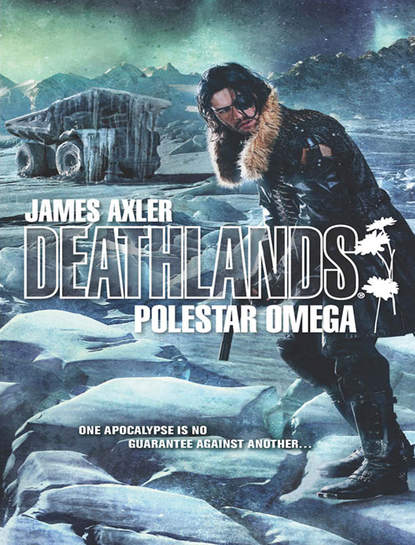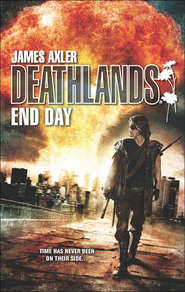По всем вопросам обращайтесь на: info@litportal.ru
(©) 2003-2024.
✖
Polestar Omega
Настройки чтения
Размер шрифта
Высота строк
Поля
Bare feet and puddles of love juice on polished concrete made for poor traction. The onrushing stickies slipped and slid, some fell, some dropped to all fours, scrambling to try to gain purchase, which gave the companions a momentary advantage. Ryan lunged forward, bringing his panga down in a tight, full-power arc. The heavy blade split the crown of a kneeling stickie’s skull, cleaving it apart like a ball of soft, moist cheese all the way to the chin. When he ripped the panga free, dark blood geysered from the crevice and sprayed across the tops of his boots.
Blasterfire roared in his right ear as Doc, Krysty and Mildred shot into the uncoiling mob of muties. The stickies dropped in bunches, as if their strings had been cut. Each high-powered slug passed through three or more bodies before ricocheting off the back wall. Their skinny torsos and soft skeletons weren’t substantial enough to slow the bullets’ flight. In such tight quarters, bounded on three sides by concrete walls, free fire was very dangerous.
A point brought home as Ricky fired his Webley Mark VI into a mutie’s open mouth. The heavy .45 ACP bullet took off the back of the stickie’s head, sparked off steel stair railing, sparked off the concrete and then whizzed past Ryan’s ear, whining down the hallway behind them.
“Back up!” Ryan shouted to the others. “Back the way we came!”
They turned as one and fell into a full retreat, running single file with Ryan bringing up the rear. Mildred and Jak had the lead with torches. Over the slap of their bootfalls and the pounding of his heart he couldn’t hear the stickies behind them, but he knew they were coming, and that they would never give up the chase. He sheathed the panga and drew his blaster. The companions sprinted blindly through the winding corridors until Mildred let out a shout.
“Got a map!” she said.
Every redoubt had floor plans, either framed behind heavy plastic or etched into the walls. It was a necessity given the complexity of the structures.
They paused only a few seconds, just long enough for Jak to read the map and find their route to safety. It was also long enough for the stickies to close the gap. With no one behind him, Ryan rapid-fired his SIG Sauer into the pale mass of bodies that filled the hallway, wall-to-wall. Torchlight glittered in a sea of black eyes.
“Go! Go!” he shouted, as the blaster’s muzzle flashed and stickies dropped in bunches, tripping those running up behind them.
Ryan stopped when the slide locked back on an empty chamber, then turned. The hallway ahead was already dark, only a faint light coming from his companions’ torches. As he ran, by feel he dropped the empty mag into his palm, pocketed it and reloaded. Really pouring on the speed, he caught up to his friends as they mounted another stairway, this one free of mating muties.
Jak led them three floors up, down a long corridor, and unerringly to the redoubt’s mat-trans. As they rushed through the anteroom’s doorway, Ryan stopped. “Get into the mat-trans and get ready to jump,” he said. “I’ll hold them off here.”
Ryan holstered the SIG Sauer. It was a last resort. In his mind’s eye was the image of the hallway jammed with pale bobbing heads and spindly waving arms. An unending supply of muties. And a limited supply of bullets. He drew the panga, quickly wiping the sweat and blood from his hand on his pants. He could hear their feet slapping the concrete and their mewling, and braced himself to defend the entrance.
“Are you ready?” he shouted over his shoulder.
There was no answer.
“Are you ready?”
Then he heard the deep, resonant hum of the mat-trans. He looked over his shoulder and his heart sank when he saw the mat-trans door was sealed. The transfer was already in progress. The companions had left him behind.
To die.
With forehand and backhand slashes of the long knife, he chopped down the first wave of stickies, lopping off heads, arms, hands indiscriminately. But he couldn’t keep up the pace for long; no one could. There were too many of them and they leaped over the bodies of their dead. Before he could reach for the SIG Sauer, suckered hands gripped his arms and face, tearing at his flesh. As the mass of stickies pulled him to the floor, he felt a wetness spreading between his legs. He was pissing himself, and it burned like fire going out.
The sensation brought him back to consciousness.
With a loud clunk the rushing sound above him abruptly stopped and the upward suction ceased. The bed frame began trembling so violently that it started to walk across the floor. The window glass shimmied in its frame. Was he dreaming this, too? Or was the redoubt coming apart? Were the hundreds of thousands of tons of concrete and steel about to collapse, crushing them, burying them forever? Everything in the room was shaking, clattering. He realized this was no hallucination; this was real.
The connecting door opened, and whitecoats and black suits rushed in.
Ryan couldn’t move. All his strength was gone. Over the rattling bed and the pounding in his skull, he heard them talking.
“His body temperature is 106,” one of the women said. “And climbing.”
“We need to get him into the tank at once. Uncuff him.”
Ryan was lifted bodily under the arms and dumped feet first and fully clothed into the ice-filled water.
It didn’t feel cold.
Tears streaming from his good eye, Ryan threw back his head and screamed.
It felt like molten metal.
Chapter Four (#ulink_7f2d2eb5-f039-5ccb-be87-8f6865f16568)
As Dr. Lima exited through the double doors, he removed his respirator and stowed it in the rather small pocket of his lab coat. The breathing mask stuck out the top and made an unsightly bulge at his hip. The precaution was annoying and probably unnecessary, but protocols for the Deathlands’ research had been laid out, and they had to be followed to the letter or there would be hell to pay. He walked briskly to the nearest elevator, entered and pressed the button for the main level.
His bioengineering complex had suffered no serious damage from the icequake, which was a relief as further delays could well prove catastrophic, both to him personally and to the population of Polestar Omega. The temblor was minor, but seismic events were coming more frequently. That was to be expected given the location—the redoubt’s main shaft had been sunk deep in the Ross Ice Sheet at a great cost in lives and 1990s tax dollars—and given the age of the structure. Its original designers had estimated it wouldn’t last much more than a century what with the pressure of a moving glacier and constant erosion by the rock and sediment trapped in the ice. Though it was linked to the global mat-trans system, the self-supporting research complex had not been created to survive an all-out nuclear exchange; that turned out to be a happy consequence of their extreme isolation.
All good things came to an end, it seemed.
The elevator stopped with a jolt, and he stepped out into a vast, domed, well-lit space. As he descended the wide, spiraling staircase of the main rotunda, he saw lines of workers in blue moving heavy crates and 55-gallon drums on four-wheeled dollies to the staging areas. The contents of the containers were identified by stencil markings on the sides and tops. Small arms—rifles, SMGs and handguns. Ammunition. Grenades and grenade launchers. Medical supplies. Water. Food. Pop-up shelters. The essentials for invasion. Because the elevators on the up-glacier side of the redoubt were no longer functional, the materiel stored there had to travel the long way around, through the center of the complex to the lifts on the lee side. The workers moved with all due haste; everyone knew the window for escape and survival of the enclave was rapidly closing.
Lima’s stomach growled. He was used to the sound, and to the accompanying gnawing sense of hunger. Never in his life, or his father’s life, or his father’s father’s life had there been quite enough for everyone to eat. All food had been carefully weighed and parceled out—particularly protein, the precious building block of life. Nothing was ever wasted. Of late, because of the stockpiling necessary to supply the invasion, the situation had become even graver, the residents of the redoubt were eating once every other day. He had seven hours to wait for his next meal.
For the doctor and the other residents, the aches in their stomachs were a matter of pride and cultural bonding. From its inception, Polestar Omega had a unique tradition, grounded in extreme physical and psychological hardship. The first whitecoats who inhabited the redoubt had been chosen for their ability to meet the challenges and deprivation of multiyear Antarctic assignments, the same selection criteria as the astronauts on the orbiting space station. Over the decades postnukecaust, the redoubt’s population had proved over and over how Spartan and how ingenious they were. If, as the saying went “you are what you eat,” they could and did live on anything that contained essential nourishment. They had exploited all the polar desert had to offer, gathering new information and using it to adapt and thrive in the most desolate place on the planet.
What could such a people, with their determination and advanced technology, accomplish in a wider world? Were there any limits on what they could do? They had known this day would come for more than a century, and for the past fifty years they had been developing a plan to take back their birthright, to leave their icebound prison, to cleanse and repopulate the Earth with a new and improved humanity and a human society based on scientific principles.
Lima moved against the flow of wheeled carts on the main floor, turning through a double doorway into the redoubt’s amphitheater. Below him and the curving rows of empty seats, on the proscenium stage two men and a woman in orange coveralls sat at a long table, attended to by scurrying staff, likewise clad in orange. The theater was the nerve center of redoubt, once the locus of scientific debate and decision making. Priorities had changed. It had been renamed the War Room twenty years ago.
The entire back wall of the stage was covered by an enormous, electronic Mercator projection map of Earth with infrared overlays from the satellite they had launched a decade ago. The missile and its satellite had been part of the research station’s infrastructure, defended from the nukeday e-mag pulse by deep burial in the glacier and massive concrete shielding. Reprogrammed from its original function, the satellite now tracked prevailing wind patterns and identified and monitored the planet’s most dangerous radiation zones and surviving population hubs. It also provided GPS and a vital communication link between forces in the field.
General Charlie India, his bald pate gleaming in the shifting, multicolored lights of the map display, looked up from the folders spread out before him, and locked eyes with Lima as he mounted the steps to the stage. The general’s orange coveralls accentuated his ice-tan: pale forehead, ears, cheeks and lower face where they had been shielded by a coldsuit’s tight-fitting hood; skin reddish and windburned looking around exposed eyes, nose, mouth and brows.
General India and the two other orange suits at the table, Commander Mike Romeo and Commander Quebec Sierra, were the military officers in charge of staging the evacuation of Polestar Omega and the invasion of the closest continental landmass to the redoubt, nearly three thousand miles distant at Tierra del Fuego, Argentina.
“I hope to hell you’re not here to tell us the icequake has stopped progress on viral deployment,” India said. “We’re tired of your excuses and delays. They will no longer be tolerated.”
“No damage was reported, sir. None at all, sir.”
Lima deeply resented the implication that the units under his command were somehow dragging their feet, or worse—scientifically incompetent or methodologically overmatched. His was by far the most technically demanding element in the plan for conquest. Yet he knew explaining that to military leaders was an exercise in futility, as was expecting them to fully fathom the tragedy of what they were being forced to leave behind. Though the facility’s original staff had all been scientists—university-trained PhDs in biochemistry, genetics, physics, mathematics, cybernetics and space science—and were focused on a single challenge with ramifications for all of humankind, a century of fighting for survival had forced a branching of personality types, intellectual and physical capacities, and job specialization, which in turn had led to the current, highly stratified society and a color-coded division of labor with hot orange at the apex.
“Have you extracted what you need from the new test subjects you acquired?” Commander Sierra asked.
Though she filled out her tailored coveralls admirably, front and rear, her hatchet face, hard, dark eyes and discolored teeth were not material for sexual fantasies—even in Antarctica.
“The process is well underway,” Lima assured her. Cracking the code to switch on a universal mutie death gene remained the key missing piece of the puzzle—he didn’t feel compelled to clarify that tiny detail. The bioengineering section had already crafted the viral transfer mechanism. All they needed was the magic bullet.
“Can you give us an updated delivery date?” Commander Romeo said. He was the youngest of the three, his face prematurely weather-seamed, his hair flecked with gray above the ears.
“I should have a result in the next twenty-four hours,” Lima said with as much confidence as he could fake. Before they abandoned the redoubt, it was vital that the infectious lethal agent be in full-scale production and ready for deployment when they made landfall. Leaving the redoubt before the magic-bullet genetic research was complete would mean constructing new isolation chambers and DNA labs in South America. The trio of military leaders had steadfastly refused to devote limited resources to that kind of duplication of effort.
They needed the kill switch, and they needed it quickly.
The expressed goal was to be sitting at the southern border of Deathlands in five years, and to have consolidated all the territorial gains in between. It was a tall order no matter the size of the army, no matter how determined or well equipped they were. That’s where the viral cleansing came in. They planned to move their main force up the remnants of north-south, predark highway corridors, spreading the death gene with hovertrucks and aerial sprayers as they advanced. They didn’t have to deploy it very far past the roadbeds; the virus and its lethal switch would move from mutie to mutie, jumping species and geographical boundaries, destroying the genetically compromised.











